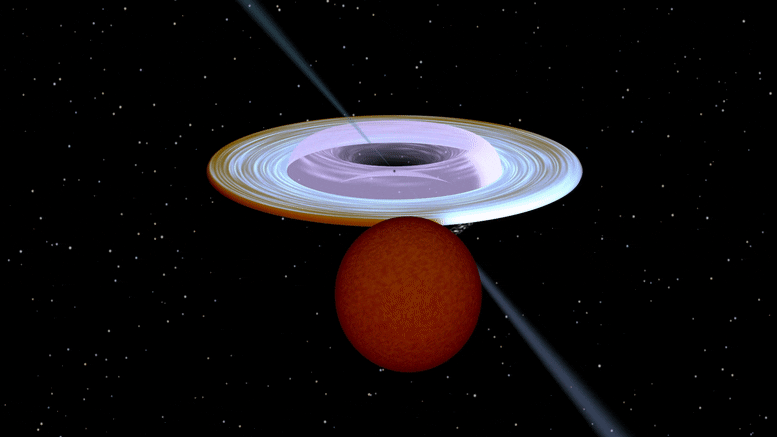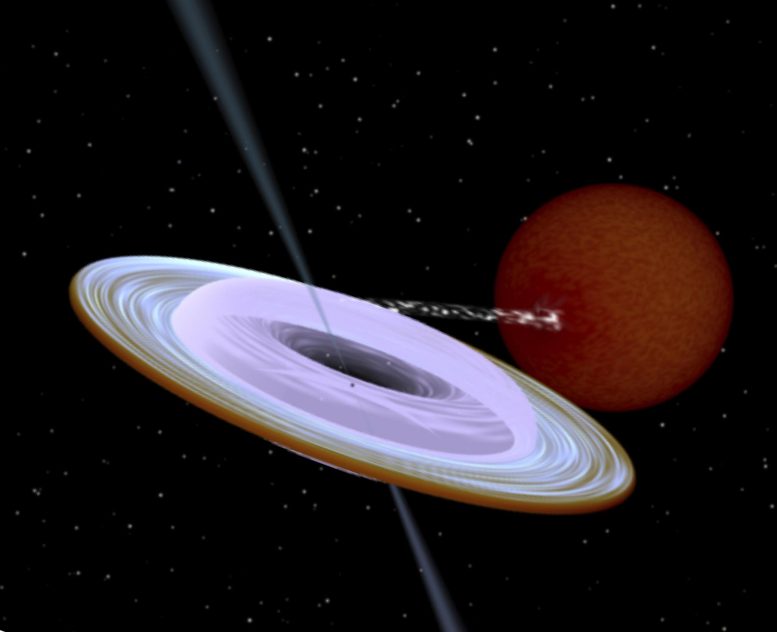
Científicos de la Universidad de Turku en Finlandia han descubierto que el eje de rotación de un[{» attribute=»»>black hole in a binary system is tilted more than 40 degrees relative to the axis of stellar orbit. The finding challenges current theoretical models of black hole formation.
The observation by the researchers from Tuorla Observatory in Finland is the first reliable measurement that shows a large difference between the axis of rotation of a black hole and the axis of a binary system orbit. The difference between the axes measured by the researchers in a binary star system called MAXI J1820+070 was more than 40 degrees.

Artist impression of the X-ray binary system MAXI J1820+070 containing a black hole (small black dot at the center of the gaseous disk) and a companion star. A narrow jet is directed along the black hole spin axis, which is strongly misaligned from the rotation axis of the orbit. Image produced with Binsim. Credit: R. Hynes
Often for the space systems with smaller objects orbiting around the central massive body, the own rotation axis of this body is to a high degree aligned with the rotation axis of its satellites. This is true also for our solar system: the planets orbit around the Sun in a plane, which roughly coincides with the equatorial plane of the Sun. The inclination of the Sun rotation axis with respect to orbital axis of the Earth is only seven degrees.
“The expectation of alignment, to a large degree, does not hold for the bizarre objects such as black hole X-ray binaries. The black holes in these systems were formed as a result of a cosmic cataclysm – the collapse of a massive star. Now we see the black hole dragging matter from the nearby, lighter companion star orbiting around it. We see bright optical and X-ray radiation as the last sigh of the infalling material, and also radio emission from the relativistic jets expelled from the system,” says Juri Poutanen, Professor of Astronomy at the University of Turku and the lead author of the publication.
https://www.youtube.com/watch?v=WfapWdqWYIo:
Impresión artística del sistema binario de rayos X MAXI J1820 + 070, que contiene un agujero (un pequeño punto en el centro del disco de gas) – una estrella compañera. El chorro estrecho se dirige a lo largo del eje de rotación de la cavidad, lo que está muy mal con el eje de rotación de la órbita. Imagen cortesía de Binsim. Préstamo: R. Hynes
Siguiendo estos chorros, los investigadores pudieron determinar la dirección del eje de rotación de la cavidad con mucha precisión. A medida que la cantidad de gas que caía de la estrella compañera hacia la cavidad comenzó a disminuir, el sistema se oscureció y la mayor parte de la luz del sistema provenía de la estrella compañera. De esta forma, los investigadores pudieron medir la pendiente de la órbita mediante técnicas espectroscópicas, que casi coincidía con la pendiente de las emisiones.
«Para determinar la orientación 3D de la órbita, es necesario conocer el ángulo de posición del sistema en el cielo, es decir, cómo gira el sistema hacia el norte del cielo. «Se midió con un polarímetro», dijo Yuri Putanen.
Los resultados, publicados en la revista Science, ofrecen perspectivas interesantes para estudiar la evolución de estos sistemas de formación de cavidades, ya que tales desequilibrios extremos son difíciles de lograr en muchos escenarios de evolución binaria.
La diferencia de más de 40 grados entre la rotación del eje de la órbita y su cavidad fue completamente inesperada. Los científicos a menudo han asumido que esta diferencia es muy pequeña cuando modelan el comportamiento de la materia en un espacio-tiempo curvo alrededor de la cavidad. «Los modelos actuales son realmente sofisticados, y ahora los nuevos hallazgos nos obligan a agregarles una nueva dimensión», dijo Putanen.
Referencia. «Error binario de rayos X MAXI J1820 + 070» por Yuri Putanen, Alexandra Veledina, Andrey V. Berdyugin, Svetlana V. Berdyugin, Helen Jermak, Peter G. Jonker, Yari J. UN. Kosenkov, Vadim Kravtsov, Vilpu Pirola, Manisha Shreshta, Manuel A. Pérez Torres և Sergey S. Tsigankov, 24 de febrero de 2022 Ciencia:.
DOI: 10.1126 / ciencia.abl4679:
El principal descubrimiento se realizó utilizando una copiadora DIPol-UF montada en el Telescopio Óptico del Norte, que pertenece a la Universidad de Turku և University. Universidad de Aarhus En Dinamarca.
También te puede interesar
-
El telescopio espacial Webb de la NASA detecta vapor de agua en la zona de formación de planetas rocosos
-
Una línea escondida en las profundidades del océano divide a los animales en dos campos. Alerta científica:
-
El Telescopio Espacial James Webb detecta agua cerca del centro del disco en formación del planeta
-
La misión de impacto de asteroides de la NASA desencadena una avalancha sorpresa de rocas espaciales. Alerta científica:
-
La armadura secreta de los ratones espinosos africanos